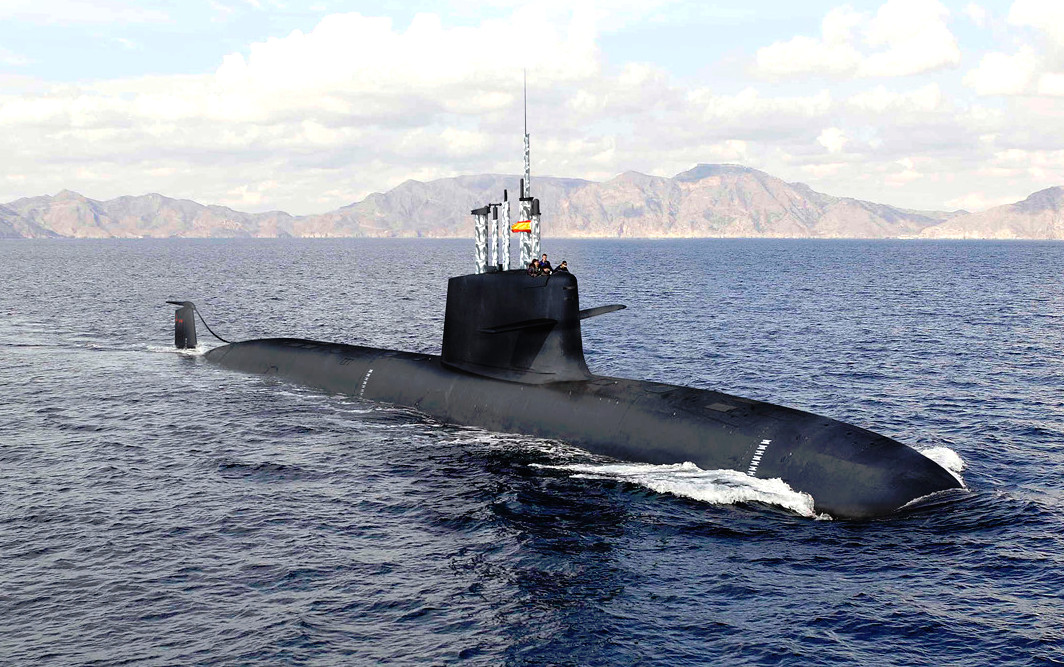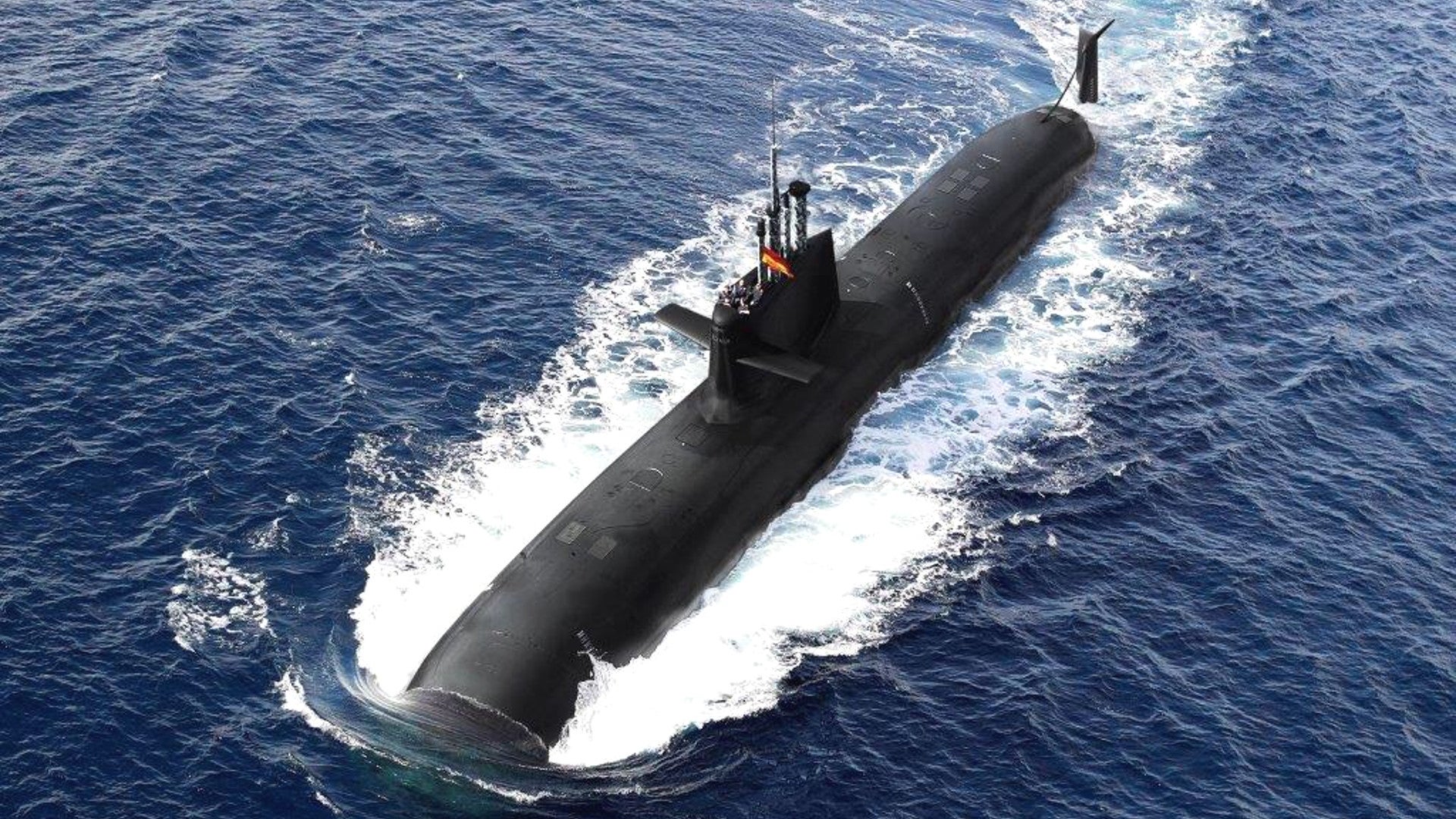Spain’s diesel-electric S-80 Plus submarine program has hit a new snag, with the boats now reportedly being too big for the existing pens at the Spanish Navy’s base in Cartagena. It could take millions of dollars to improve the facilities and the issue underscores the hurdles the country and many of its
fellow NATO members face in attempting to revitalize their military capabilities after years of post-Cold War neglect.
Spanish newspaper El País
was first to report on the new developments on July 18, 2018. The outlet included graphics highlighting that the docks at Cartagena are just shy of 256 feet long, while the S-80 Plus is over 265 feet long. The report also said that Spanish authorities would have to dredge out the pens to accommodate the new boats, which are larger overall compared to the country’s existing S-70 Galerna-class submarines, with the complete upgrades to the facilities costing more than $18 million.
“There have been deficiencies in the project,” Margarita Robles, Spain’s Defense Minister, who took up the post in June 2018, had said in a separate radio interview, according to the BBC. “They are already corrected and that the project is absolutely viable.”
The issue is that the S-80 Plus is larger than manufacturer Navantia had said it would be when the Spanish government approved construction of four boats all the way back in 2003. The program to develop a new submarine for Spain’s Navy dates back to before the end of the Cold War, at which time it was a joint Franco-Spanish effort.
Both countries shelved what was originally known simply as the S-80 project after the Soviet Union collapsed in 1991, but rebooted their efforts separately it in the late 1990s. Delays and economic upheaval repeatedly extended the new Spanish submarine project over the next decade.
Then, in 2013, Navantia uncovered a serious and potentially fatal design flaw. The addition of more than 100 tons of added weight during development had thrown off the boat’s buoyancy characteristics, which meant it might not be able to resurface reliably.

“Apparently somebody in the calculations made a mistake in the very beginning and nobody paid attention to review the calculations,” Rafael Bardaji, formerly the director of the Office of Strategic Assessment at Spain’s Defense Ministry and subsequently a defense consultant, said at the time. He blamed the matter on a single misplaced decimal point.
The company, with outside help from American sub maker Electric Boat, a division of General Dynamics, eventually added 16 distinct extensions in the hull, renaming the resulting design the S-80 Plus. The entire modification program cost more than $18 million and set back the already protracted production schedule.
Spain originally expected to have the first boat in hand by 2015 and take delivery of the last one in 2018. As of January 2018, Navantia’s goal was to have the first submarine finished by 2022 – nearly two decades after the Spanish government approved the project.
According to Matthew Bennett, an independent journalist, Spanish authorities have already pushed back against
El País’ report. They noted that the Spanish Ministry of Defense, or MoD, has had plans to enlarge the width of the pens at Cartagena and otherwise improve the facilities since 2009.
“There is no modification of the project or decision taken in the MoD that implies the lengthening of the pens for the submarines,” an unnamed spokesperson told Bennett. “It is possible that they won’t need lengthening because they don’t have to fit on the dock lengthways anyway.”
This logic seems dubious, though, since it would expose their tails and present a potential hazard to the boats and other marine traffic within the base’s harbor area. It is possible that the S-80 Plus could fit inside the existing space diagonally, but this seems to be an ad hoc solution at best.

In addition, this would limit the ability of the pens to each accommodate two submarines, as they do now. This, in turn, could require Spain to have to modify or build alternate pier side space for all four S-80 Plus boats, which could require additional funds.
Regardless, the S-80 Plus program still has other issues to overcome, chiefly with its fuel-cell based air-independent propulsion (AIP) system. This type of arrangement is a core feature in any modern non-nuclear submarine designs. The technology is steadily advancing to the point that boats with AIP systems, as well as improved batteries, may be quieter, and therefore stealthier and more survivable, than nuclear-powered types and be able to remain underwater for weeks at a time.
But rather than leverage an in-production system or hire an established manufacturer to build a new one specifically for the S-80 Plus, Spain hired two domestic firms, Técnicas Reunidas and Abengoa, to build one. By most accounts, their design has been underperforming, with past demonstrations indicating that the system will be able to propel the boats while submerged for 21 days, a week shorter than required.
These problems appear to have put plans to export the design on hold, as well. In October 2017, Navantia decided not to enter the S-80 Plus in an Indian Navy submarine competition, despite its initial interest in the program.

According to El País, Spanish authorities are now expecting to take delivery of the first two S-80 Plus submarines – the future S-81 Isaac Peral and S-82 Narciso Monturiol – with a traditional diesel-electric propulsion system. The third and fourth examples – the S-83 Cosme García and S-84 Mateo García de los Reyes – which are now expected to enter service in 2026 and 2028 respectively, would be the first in an AIP configuration. The Spanish Navy would then upgrade the Peral and Monturiol with the improved propulsion system when they arrive at their first major maintenance availability, expected to come around 2032.
This plan might help get the initial submarines into service faster, but it would almost certainly be costly and complex to modify the S-81 and S-82 with the AIP system further on down the line. The total cost of the S-80 Plus program has already risen from more than $2 billion in 2003 to nearly twice that amount.
Without the AIP system, the capabilities of the first two submarines will be significantly limited in that intervening decade. This will impact not only Spain’s ability to conduct underwater operations, but also support its NATO allies during any potential contingency.
Spain, along with other members of the alliance, has already come under fire from U.S. President Donald Trump and his administration for not contributing more to the bloc. In 2017, Spain was fourth from the bottom in defense spending among NATO allies, ahead of only Belgium, Luxembourg, and Iceland, the last of which has a special exemption from the organization’s goal of member states spending two percent on national security.

What the Spanish government does spend it does “in a very active manner,” Josep Borrell, the country’s Foreign Minister, said in July 2018, ahead of what turned out to be a very controversial NATO summit. “So we spend less, but we use it really well.”
Spain is an active contributor to various NATO missions, including training activities in Afghanistan and Iraq, as well as the Baltic Air Policing operation. It has troops in Latvia as part of the alliance’s effort to increase its deterrent posture in the face of Russia’s ever more aggressive
foreign policy agenda and has a battery of Patriot surface-to-air missiles guarding Turkish airspace against potential air and ballistic missile threats in that region.
And to be fair, Spain suffered greatly in the global economic downturn that began in 2008. Political shifts in leadership between the country’s conservative and socialist political blocs have also had impacts on defense spending.
Unfortunately, the latest hurdles for the S-80 Plus program show that the country still faces significant hurdles as it tries to modernize its military capabilities.
Contact the author: jtrevithickpr@gmail.com
